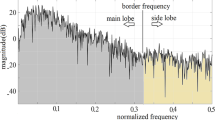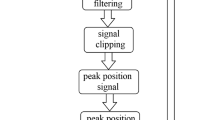Abstract
EMG was recorded during short test contractions performed during occupational work. Mean power frequency (MPF) and median frequency (MF), calculated from EMG spectra, and zero crossing rate (ZC) of the EMG signal were compared as estimators of local muscular fatigue. The results show that there is a systematic difference between the three estimates. The difference can be explained by dividing the effect of muscle fatigue on EMG spectra into a motor unit action potential velocity effect and a firing statistics effect. Furthermore, it is shown that the phenomenon of increasing estimators of EMG spectrum shift is unlikely to be caused by motor unit action potential velocity increase. Successive recruitment of new motor units is suggested as a feasible explanation.
Similar content being viewed by others
References
Basmajian, J. andDeluca, C. J. (1985)Muscles alive, 5th edn. Williams & Wilkins, Baltimore, USA.
Bigland-Ritchie, B., Bonovan, E. F. andRoussos, C. S. (1981) Conduction velocity and EMG power spectrum changes in fatigue of sustained maximal efforts.J. Appl. Physiol.,51, 1300–1305.
Blinowska, A. J., Verroust, J. andCannet, G. (1980) An analysis of synchronization and double discharge effects on low frequency electromyographic power spectra.Electromyogr. Clin. Neurophysiol.,20, 465–480.
Broman, H., Bilotto, G. andDeLuca, C. (1985) Myoelectric signal conduction velocity and spectral parameters: influence of force and time.J. Appl. Physiol.,58, 1428–1437.
Buchtal, F. andMadsen, A. (1950) Synchronous activity in normal and atrophic muscle.Electroenceph. Clin. Neurophysiol.,2, 425–444.
Chaffin, D. (1973) Localized muscle fatigue—definition and measurement,J. Occup. Med.,15, 346–354.
Eason, R. G. (1960) Electromyographic study of local and generalized muscular impairment.J. Appl. Physiol.,15, 479–482.
Edwards, R. G. andLippold, O. C. (1956) The relation between force and integrated electrical activity in fatigued muscle.J. Physiol.,132, 677–681.
Hagberg, M. (1981) Muscular endurance and surface electromyogram in isometric and dynamic exercise.J. Appl. Physiol.,51, 1–7.
Hägg, G. (1981) Electromyographic fatigue analysis based on the number of zero crossings.Pflügers Arch.,391, 78–80.
Hägg, G. M., Suurküla, J. andLiew, M. (1987) A worksite method for shoulder muscle fatigue measurements using EMG, test contraction and zero crossing technique.Ergonomics,30, 1541–1551.
Inbar, G. F., Allin, J., Paiss, O. andKranz, H. (1986) Monitoring surface EMG spectral changes by the zero crossing rate.Med. & Biol. Eng. & Comput.,24, 10–18.
Kadefors, R., Petersén, I. andHerberts, P. (1976) Muscular reaction to welding work: An electromyographic investigation.Ergonomics,19, 543–558.
Krantz, H., Williams, A. M., Cassel, J., Caddy, D. J. andSilberstein, R. B. (1983) Factors determining the frequency content of the electromyogram.J. Appl. Physiol.,55, 392–399.
Kwatny, E., Thomas, D. H. andKwatny, H. G. (1970) An application of signal processing techniques to the study of myoelectric signals.IEEE Trans.,BME-17, 303–312.
Lindström, L., Magnusson, R. andPetersén, I. (1970) Muscular fatigue and action potential conduction velocity changes studied with frequency analysis of EMG signals.Electromyogr.,10, 341–356.
Lindström, L., Kadefors, R. andPetersen, I. (1977) An electromyographic index for localized muscle fatigue.J. Appl. Physiol.,43, 750–754.
Malmqvist, R., Ekholm, I., Lindström, L., Petersen, I., Örtengren, R., Bjurö, T., Herberts, P. andKadefors, R. (1981) Measurement of localized muscle fatigue in building work.Ergonomics,24, 695–709.
Maton, B. (1981) Human motor unit activity during the onset of muscle fatigue in submaximal isometric isotonic contraction.J. Appl. Physiol.,46, 271–281.
Merletti, R., Sabbahi, M. A. andDeLuca, C. J. (1984) Median frequency of the myoelectric signal. Effects of muscle ischemia and cooling.Eur. J. Appl. Physiol.,52, 258–265.
Merletti, R., Knaflitz, M. andDeLuca, C. J. (1990) Myoelectric manifestations of fatigue in voluntary and electrically elicited muscle contractions.J. Appl. Physiol.,69, 1810–1820.
Moritani, T., Muro, M. andNagata, A. (1986) Intramuscular and surface electromyogram changes during muscle fatigue.Eur. J. Appl. Physiol.,60, 1179–1185.
Pan, Z. S., Zhang, Y. andParker, P. A. (1989) Motor unit power spectrum and firing rate.Med. & Biol. Eng. & Comput.,27, 14–18.
Rice, R. O. (1945) Mathematical analysis of random noise. InSelected papers on noise and stochastic processes.Wax, N. (Ed.), Dover Publications, New York, 133–145.
Sadoyama, T., Masuda, T. andMiyano, H. (1983) Relationships between fibre conduction velocity and frequency parameters of surface EMG during sustains contraction.Eur. J. Appl. Physiol.,51, 247–256.
Stulen, F. B. andDeLuca, C. J. (1981) Frequency parameters of the myoelectric signal as a measure of muscle conduction velocity.IEEE Trans.,BME-28, 515–523.
Suurküla, J. andHägg, M. (1987) Relations between shoulder/neck disorders and EMG zero crossing shifts in female assembly workers using the test contraction method.Ergonomics,30, 1553–1564.
VanBoxtel, A. andSchomaker, L. R. B. (1984) Influence of motor unit firing statistics on the median frequency of the EMG power spectrum.Eur. J. Appl. Physiol.,52, 207–213.
Vitasalo, J. H. T. andKomi, P. (1977) Signal characteristics of EMG during fatigue.,37, 111–121.
Zwarts, M. J., van Weerden, T. W. andHaenen, H. T. M. (1987) Relationship between average muscle fibre conduction velocity and EMG power spectra during isometric contraction, recovery and applied ischemia.,56, 212–216.
Author information
Authors and Affiliations
Rights and permissions
About this article
Cite this article
Hägg, G.M. Comparison of different estimators of electromyographic spectral shifts during work when applied on short test contractions. Med. Biol. Eng. Comput. 29, 511–516 (1991). https://doi.org/10.1007/BF02442323
Received:
Accepted:
Issue Date:
DOI: https://doi.org/10.1007/BF02442323




